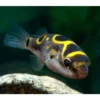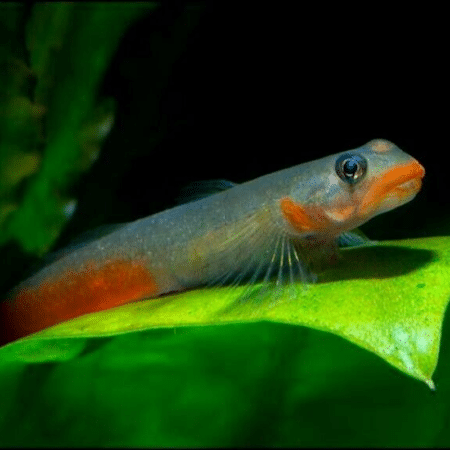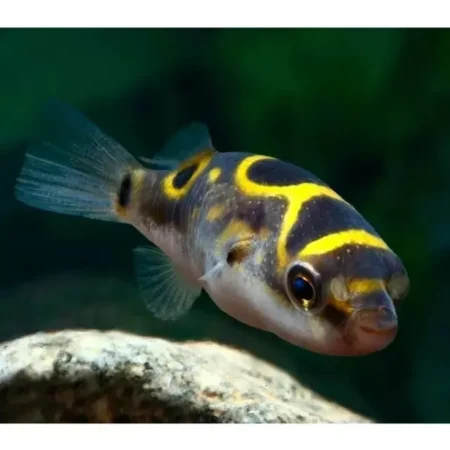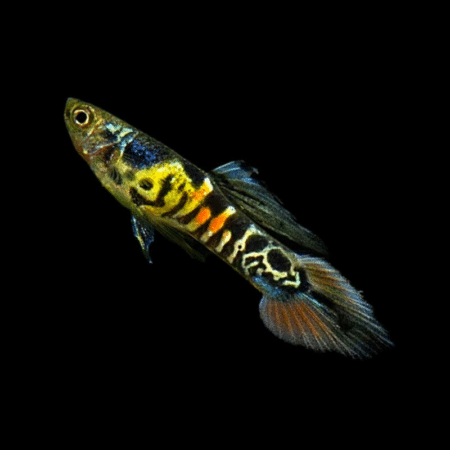Indian Dwarf Pea Malabar Pygmy Puffer Fish Carinotetraodon Travancoricus, Stunning Freshwater Fish for Your Community Tank – Easy Care and Compatibility Insights, A Beautiful Addition to Your Aquarium
£9.49 Original price was: £9.49.£7.74Current price is: £7.74.
Welcome these beautiful Indian Dwarf Pea Malabar Pygmy Puffer Fish, or Carinotetraodon Travancoricus, into your freshwater aquarium. Their stunning colors and peaceful nature make them ideal community tank members. Perfect for aquarists seeking vibrant, easy-care fish!
Species Introduction
The Indian Dwarf Pea Malabar Pygmy Puffer Fish, scientifically known as Carinotetraodon travancoricus, is a captivating species native to the freshwater streams and rivers of the Western Ghats in India. This small tropical fish typically reaches a maximum length of about 4 cm, making it an ideal choice for aquarists looking to add a vibrant yet manageable species to their community tank.
In their natural habitat, these puffer fish inhabit densely vegetated areas with slow-moving waters, providing ample hiding spots and foraging opportunities. Their striking appearance, characterized by a rounded body and bright coloration, adds beauty to any aquarium setup. These fish are not only visually appealing but also exhibit fascinating behaviors that can enrich the aquarium experience.
Care Requirements Dashboard
| Optimal Living Conditions | |
|---|---|
| Water Temperature | 24-27°C (75-81°F) |
| pH Level | 6.5-7.5 |
| Water Hardness | 4-12 dKH |
| Minimum Tank Size | 80L (20 gal) |
| Salinity | Freshwater |
| Care Level | Beginner Friendly |
Natural Behavior & Temperament
The Indian Dwarf Pea Puffer Fish is known for its playful and curious nature. These fish are active swimmers, often darting around their tank in search of food and exploring their environment. They exhibit a range of social behaviors, often interacting with their tank mates, though they can be territorial, particularly during breeding. In a community tank, it is essential to provide plenty of hiding spots and visual barriers to reduce stress and aggression. Their inquisitive nature makes them a joy to observe as they engage in playful antics and display their vibrant colors.
Tank Setup Guide
Setting up a suitable environment for your Indian Dwarf Pea Puffer Fish is crucial for their well-being and longevity. These fish prefer a densely planted tank with plenty of hiding spots created by rocks, driftwood, and live plants. A fine substrate, such as sand or small gravel, mimics their natural habitat and allows them to forage comfortably. Incorporating floating plants can provide shade and create a more natural atmosphere. It is important to maintain a gentle water flow, as these fish thrive in calm waters.
Water Quality Management
Maintaining optimal water quality is vital for the health of your Indian Dwarf Pea Puffer Fish. Regular testing of pH, temperature, and hardness is recommended to ensure that these parameters remain within the ideal ranges. The pH level should be kept between 6.5 and 7.5, while the temperature should be maintained between 24°C and 28°C (75°F – 82°F). Water hardness should ideally be between 5-15 dGH. To achieve this, consider using a high-quality aquarium filter and performing regular water changes of 20-30% weekly.
Feeding & Nutrition
The diet of the Indian Dwarf Pea Puffer Fish should consist of high-quality foods to ensure their health and vitality. These fish are carnivorous, and their diet should include live or frozen foods such as bloodworms, brine shrimp, and daphnia. Additionally, high-quality sinking pellets formulated for puffer fish can be offered. It is crucial to feed them small amounts several times a day rather than one large feeding to prevent overfeeding and maintain water quality.
Compatibility Guide
When considering tank mates for your Indian Dwarf Pea Puffer Fish, it is essential to choose peaceful species that can coexist harmoniously. Suitable companions include small, non-aggressive fish such as neon tetras, guppies, and rasboras. However, avoid larger or more aggressive fish, as they may intimidate or harm your puffer fish. It is also advisable to keep only one male puffer fish in a community tank to prevent territorial disputes.
Health & Wellness
Monitoring the health of your Indian Dwarf Pea Puffer Fish involves observing their behavior and physical appearance. Common health issues include ich, fin rot, and swim bladder disorders. Signs of illness may include lethargy, loss of appetite, or abnormal swimming patterns. To prevent these issues, maintain optimal water quality and provide a balanced diet. Regularly inspect your fish for any signs of distress or disease, and promptly address any health concerns.
Breeding Information
Breeding Indian Dwarf Pea Puffer Fish can be a rewarding experience for aquarists. These fish typically reach sexual maturity at around 6 months of age. To encourage breeding, provide a separate breeding tank with soft, slightly acidic water and plenty of hiding spots. During the breeding process, males will display vibrant colors and engage in courtship behaviors. After spawning, the female will lay eggs on flat surfaces, which should be removed to prevent the parents from eating them.
Acclimation Process
Introducing your Indian Dwarf Pea Puffer Fish to a new tank requires a careful acclimation process to minimize stress. Begin by floating the sealed bag containing the fish in the tank for about 15-20 minutes to equalize the temperature. After this, gradually introduce tank water into the bag over the course of an hour, allowing the fish to adjust to the new water parameters.
Long-term Care
Caring for your Indian Dwarf Pea Puffer Fish involves understanding their lifecycle and growth expectations. These fish can live up to 5 years or more with proper care. Regular maintenance of water quality, a balanced diet, and a suitable tank environment are crucial for their longevity.
Natural Habitat Recreation
Recreating the natural habitat of the Indian Dwarf Pea Puffer Fish in your aquarium can enhance their well-being and display their natural behaviors. Aim to mimic the slow-moving waters and dense vegetation found in their native streams. Incorporate a variety of live plants, such as java moss and anubias, along with driftwood and rocks to create hiding spots and territories.
Seasonal Care Adjustments
As seasons change, so do the conditions in your aquarium. During warmer months, ensure that the water temperature does not exceed 28°C (82°F) by using fans or air conditioning to cool the room. Conversely, during colder months, consider using a heater to maintain a stable temperature within the ideal range.
Expert Tips
For those looking to provide the best care for their Indian Dwarf Pea Puffer Fish, consider the following expert tips: First, always quarantine new fish before introducing them to your main tank to prevent disease outbreaks. Second, maintain a varied diet to ensure your puffer fish receive all necessary nutrients.
Troubleshooting
If you encounter issues with your Indian Dwarf Pea Puffer Fish, it is important to address them promptly. Common problems include stress due to aggressive tank mates, poor water quality, or inadequate diet. Keeping a close eye on your fish and maintaining a proactive approach to care will help ensure their long-term health and happiness.
Scientific Background
The Indian Dwarf Pea Puffer Fish belongs to the family Tetraodontidae, known for its unique adaptations, including the ability to inflate its body as a defense mechanism. This species, Carinotetraodon travancoricus, was first described in the 1990s and has since gained popularity among aquarists due to its small size and vibrant colors.
Advanced Care Techniques
For experienced aquarists looking to enhance their care for Indian Dwarf Pea Puffer Fish, consider implementing advanced techniques such as breeding and biotope creation. Engaging in these advanced care techniques not only benefits the fish but also enriches the aquarist’s experience.
Frequently Asked Questions
Q: What tank size is required for the Indian Dwarf Pea Malabar Pygmy Puffer Fish?
The Indian Dwarf Pea Malabar Pygmy Puffer Fish thrives in a tank size of at least 30 litres. This provides ample space for them to explore and establish territories. Although they are small, they are quite active and require space to swim. A well-planted aquarium with hiding spots is ideal for their well-being. Avoid overcrowding, as this can lead to stress and aggression. Ensure that the tank has a secure lid, as these fish are known to jump. Regular water changes and maintenance are crucial to keeping the environment clean and stable.
✓ Expert Tip
Consider using a tank divider if you have multiple males to reduce territorial disputes.
Q: What water parameters do the Indian Dwarf Pea Malabar Pygmy Puffer Fish require?
Maintaining the right water parameters is crucial for the health of the Indian Dwarf Pea Malabar Pygmy Puffer Fish. They prefer slightly acidic to neutral pH levels between 6.5 and 7.5. The temperature should be kept between 24-28°C. Regularly test the water for ammonia, nitrites, and nitrates, ensuring that ammonia and nitrites are at 0 ppm, while nitrates should be kept below 20 ppm. Adequate filtration and regular water changes (at least 25% weekly) will help maintain these parameters and promote a healthy environment.
✓ Expert Tip
Use a sponge filter to avoid strong currents, which can stress these small fish.
Q: How often should I feed the Indian Dwarf Pea Malabar Pygmy Puffer Fish?
Feeding the Indian Dwarf Pea Malabar Pygmy Puffer Fish should be done 2-3 times a day with small amounts of food. Their diet should consist of high-quality pellets, frozen or live foods such as bloodworms and brine shrimp. Overfeeding can lead to health issues, so it is essential to monitor their intake. Ensure that all food is consumed within a few minutes to maintain water quality. Variety in their diet is key to ensuring they receive the necessary nutrients for optimal health.
✓ Expert Tip
Consider using a feeding ring to keep food in one area, making it easier for them to find.
Q: What are the best tank mates for the Indian Dwarf Pea Malabar Pygmy Puffer Fish?
Choosing tank mates for the Indian Dwarf Pea Malabar Pygmy Puffer Fish requires careful consideration. They are best kept with small, peaceful species that won’t compete for food or stress them. Suitable companions include small tetras, rasboras, and dwarf shrimp. Avoid larger or aggressive fish, as they may bully the puffers. It’s advisable to introduce new tank mates gradually and monitor their interactions closely to prevent any aggression or stress.
✓ Expert Tip
Always observe your aquarium for signs of stress or aggression among fish friends.
Q: How do I properly acclimatise the Indian Dwarf Pea Malabar Pygmy Puffer Fish to my aquarium?
Acclimatisation is vital for the Indian Dwarf Pea Malabar Pygmy Puffer Fish to reduce stress. Begin by floating the sealed bag containing the fish in your aquarium for about 15-20 minutes to equalise the temperature. After this, gradually introduce small amounts of your aquarium water into the bag every 5-10 minutes for at least an hour. This process helps the fish adjust to the new water chemistry. Once acclimatised, gently release the fish into the tank without adding the bag water.
✓ Expert Tip
Avoid adding too many fish at once to prevent overwhelming your aquarium’s ecosystem.
Q: What are the signs of a healthy Indian Dwarf Pea Malabar Pygmy Puffer Fish?
Healthy Indian Dwarf Pea Malabar Pygmy Puffer Fish exhibit bright colours, clear eyes, and active behaviour. They should swim freely without signs of distress. Healthy fish will also have a good appetite and show interest in food. Observe their fins and body for any signs of lesions or abnormal growths. Regularly checking these indicators will help you catch any potential health issues early, ensuring your fish remains vibrant and lively.
✓ Expert Tip
Keep a journal of your fish’s behaviour and health to spot changes over time.
Q: How do I successfully breed Indian Dwarf Pea Malabar Pygmy Puffer Fish?
Breeding Indian Dwarf Pea Malabar Pygmy Puffer Fish requires specific conditions. First, establish a breeding tank with soft, slightly acidic water and plenty of hiding spots. Introduce a ratio of one male to two females to encourage breeding behaviour. Provide high-quality live foods to promote spawning. When ready, females will lay eggs on flat surfaces, which males will fertilise. After spawning, it is advisable to remove the adults to prevent them from eating the eggs. The fry will hatch in about 3-5 days and can be fed infusoria or finely crushed food.
✓ Expert Tip
Breeding can be triggered by slight temperature increases and water changes.
Q: What temperature should I maintain for the Indian Dwarf Pea Malabar Pygmy Puffer Fish?
The ideal temperature for the Indian Dwarf Pea Malabar Pygmy Puffer Fish is between 24-28°C. Maintaining a stable temperature within this range is critical for their health and well-being. Sudden temperature fluctuations can lead to stress and susceptibility to disease. It is advisable to use a reliable aquarium heater and thermometer to monitor the temperature accurately. Regular checks will ensure that the environment remains optimal for your aquatic companions.
✓ Expert Tip
Consider using a heater with a thermostat for consistent temperature control.
Q: How long do Indian Dwarf Pea Malabar Pygmy Puffer Fish typically live in captivity?
In captivity, Indian Dwarf Pea Malabar Pygmy Puffer Fish typically live for 3-5 years, provided they are cared for in optimal conditions. Good water quality, appropriate tank mates, and a balanced diet greatly influence their lifespan. Regular monitoring of their health and environment can help identify potential issues early, thus prolonging their life. Always ensure you provide a stress-free environment with plenty of hiding spaces and enrichment to keep them happy.
✓ Expert Tip
Keep a consistent care routine to promote longevity and health.
Q: What type of substrate is most suitable for the Indian Dwarf Pea Malabar Pygmy Puffer Fish?
A soft substrate, such as fine sand or smooth gravel, is ideal for the Indian Dwarf Pea Malabar Pygmy Puffer Fish. This allows them to forage naturally without risking injury to their sensitive bodies. Avoid sharp or rough substrates that could cause damage. Additionally, adding live plants to the aquarium will not only enhance the aesthetic but also provide hiding spots and improve water quality through natural filtration.
✓ Expert Tip
Consider adding leaf litter to mimic their natural habitat, which can also provide beneficial microfauna.
Q: What behavioural patterns should I expect from the Indian Dwarf Pea Malabar Pygmy Puffer Fish?
The Indian Dwarf Pea Malabar Pygmy Puffer Fish are known for their curious and playful behaviour. They often explore their environment, darting around and investigating their surroundings. They may also exhibit territoriality, especially males, and can display aggression towards other males. It is common to observe them interacting with each other through displays of colour changes and posturing. Providing ample hiding spots and visual barriers can help reduce stress and territorial disputes.
✓ Expert Tip
Observe their behaviour regularly; it can indicate their health and happiness.
Q: How can I prevent common diseases in the Indian Dwarf Pea Malabar Pygmy Puffer Fish?
Preventing diseases in the Indian Dwarf Pea Malabar Pygmy Puffer Fish involves maintaining excellent water quality and a stable environment. Regular water changes and testing are essential. Quarantine any new fish before introducing them to the main tank to prevent the spread of disease. Ensure a well-balanced diet rich in vitamins to strengthen their immune system. Observe your fish for any signs of illness, such as changes in behaviour, appetite, or appearance, and take prompt action if needed.
✓ Expert Tip
Maintain a balanced community tank with compatible fish to reduce stress and potential disease.
Q: What lighting conditions do the Indian Dwarf Pea Malabar Pygmy Puffer Fish prefer?
Indian Dwarf Pea Malabar Pygmy Puffer Fish prefer moderate lighting, mimicking their natural habitat. Too bright lighting can cause stress and encourage algae growth, while too dim lighting may affect their feeding habits. A suitable choice is to use a combination of LED lights with a dimming feature, allowing you to adjust the intensity based on the time of day. Incorporating live plants can also help diffuse the light, creating a more natural environment.
✓ Expert Tip
Consider a lighting schedule that mimics day and night cycles to promote natural behaviour.
Q: How do I recognise stress in the Indian Dwarf Pea Malabar Pygmy Puffer Fish?
Recognising stress in the Indian Dwarf Pea Malabar Pygmy Puffer Fish is crucial for their welfare. Signs of stress may include erratic swimming patterns, hiding excessively, or a lack of interest in food. Changes in colouration can also indicate stress, with fish appearing dull or washed out. Monitor their interactions with tank mates; aggression or bullying can lead to heightened stress levels. If you observe any of these behaviours, assess their environment and make necessary adjustments to reduce stressors.
✓ Expert Tip
Create a calm environment with plenty of hiding spots to help reduce stress.
Q: What natural habitat conditions should I replicate for the Indian Dwarf Pea Malabar Pygmy Puffer Fish?
To replicate the natural habitat of the Indian Dwarf Pea Malabar Pygmy Puffer Fish, aim for a densely planted tank with plenty of hiding spots. They thrive in slow-moving waters with a slightly acidic to neutral pH. Incorporating driftwood, rocks, and leaf litter will create a more authentic environment. Maintaining stable water parameters and providing varied water flow will further enhance their well-being. Mimicking these conditions will help your fish feel more secure and comfortable in their aquarium.
✓ Expert Tip
Regularly trim plants to prevent overgrowth, ensuring your fish have enough swimming space.












